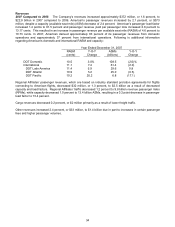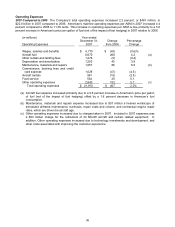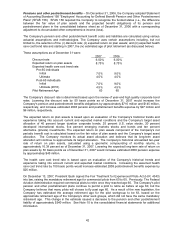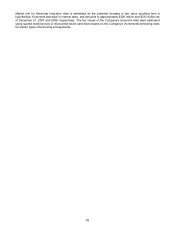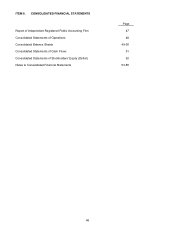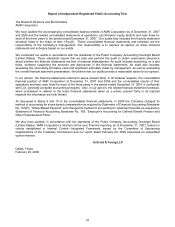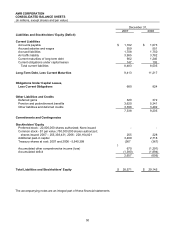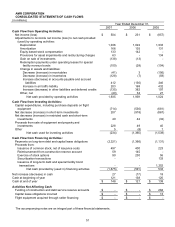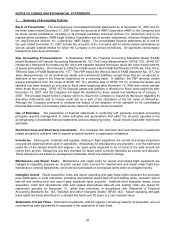American Airlines 2007 Annual Report Download - page 46
Download and view the complete annual report
Please find page 46 of the 2007 American Airlines annual report below. You can navigate through the pages in the report by either clicking on the pages listed below, or by using the keyword search tool below to find specific information within the annual report.43
The U.S. Congress is also considering legislation that would amend the Pension Protection Act of
2006. The Company has not completed its evaluation of the impact of the proposed legislation; however, if
enacted the proposed legislation could materially increase the Company’s minimum required contributions
to its defined benefit pension plans.
Income taxes – The Company generally believes that the positions taken on previously filed income tax
returns are more likely than not to be sustained by the taxing authorities. The Company has recorded
income tax and related interest liabilities where the Company believes its position may not be sustained or
where the full income tax benefit will not be recognized. In accordance with the standards of Financial
Accounting Standards Board Interpretation No. 48 “Accounting for Uncertainty in Income Taxes- an
interpretation of FASB Statement No. 109 (FIN 48), the effects of potential income tax benefits resulting
from the Company’s unrecognized tax positions are not reflected in the tax balances of the financial
statements. Recognized and unrecognized tax positions are reviewed and adjusted as events occur that
affect the Company’s judgment about the recognizability of income tax benefits, such as lapsing of
applicable statutes of limitations, conclusion of tax audits, release of administrative guidance, or rendering
of a court decision affecting a particular tax position. Under FAS 109, the Company records a deferred tax
asset valuation allowance when it is more likely than not that some portion or all of its deferred tax assets
will not be realized. The Company considers its historical earnings, trends, and outlook for future years in
making this determination. The Company had a deferred tax valuation allowance of $625 million, and $1.3
billion, respectively, at December 31, 2007 and 2006. See Note 8 to the consolidated financial statements
for additional information.
Derivatives – In accordance with Statement of Financial Accounting Standards No. 133, “Accounting for
Derivative Instruments and Hedging Activity” (SFAS 133), the Company assesses, both at the inception of
each hedge and on an on-going basis, whether the derivatives that are used in its hedging transactions are
highly effective in offsetting changes in cash flows of the hedged items. In doing so, the Company uses a
regression model to determine the correlation of the change in prices of the commodities used to hedge jet
fuel (e.g. NYMEX Heating oil) to the change in the price of jet fuel purchases. The Company also monitors
the actual dollar offset of the hedges’ market values as compared to hypothetical jet fuel hedges. The fuel
hedge contracts are generally deemed to be “highly effective” if the R-squared is greater than 80 percent
and the hedge is expected to continue to remain effective at offsetting jet fuel price changes. The
Company discontinues hedge accounting prospectively if it determines that a derivative is no longer
expected to be highly effective as a hedge. As of December 31 2007, the Company had derivative
contracts with a value of $416 million including a receivable related to contracts that settled in December.
A deferred gain of $240 million was recorded in Other comprehensive income at December 31, 2007 and
will be recognized in future periods as contracts settle.
New Accounting Pronouncements In September 2006, the Financial Accounting Standards Board (FASB)
issued Statement of Financial Accounting Standards No. 157 “Fair Value Measurements” (SFAS 157). SFAS 157
introduces a framework for measuring fair value and expands required disclosure about fair value measurements
of assets and liabilities. On February 6, 2008 the FASB issued a final FASB Staff Position (FSP) No. FAS 157-b,
“Effective Date of FASB Statement No. 157”. This FSP delays the effective date of FASB Statement No. 157, Fair
Value Measurements, for all nonfinancial assets and nonfinancial liabilities, except those that are recognized or
disclosed at fair value in the financial statements on a recurring basis. In addition, the FSP removes certain
leasing transactions from the scope of SFAS 157. The effective date of SFAS 157 for nonfinancial assets and
liabilities has been delayed by one year to fiscal years beginning after November 15, 2008 and interim periods
within those fiscal years. SFAS 157 for financial assets and liabilities is effective for fiscal years beginning after
November 15, 2007, and the Company will adopt the standard for those assets and liabilities as of January 1,
2008. The principal impact to the Company will be to require the Company to expand its disclosure regarding its
derivative instruments and to include credit risk as a part of the calculation of the fair value of derivatives.
Although the Company continues to evaluate the impact of the adoption of this standard on its consolidated
financial statements, the Company believes the impact of adoption will be immaterial.



